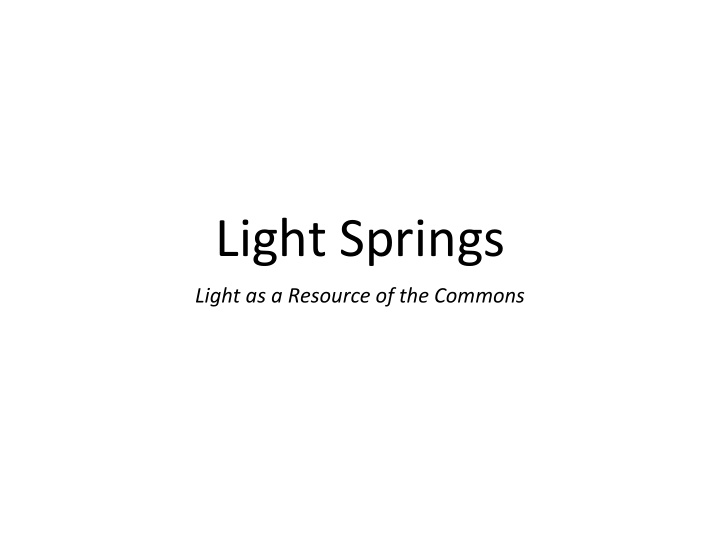



Light Springs Light as a Resource of the Commons
Light Springs Light Springs are an application of the concept of a “commons” to creative resources in technology. They are intended as a shared resource to which the community has access.
Why Light? Light, unlike raw electricity, is shaped and easily shapeable. Anyone, from a neophyte to an expert, can employ tools in light to make works in keeping with their practice. Thus it is particularly well-suited to use as a shared resource. In addition, we see growing numbers of visual artists employing light and/or projection in development of meaningful works.
The Plan • We will build three Light Springs and position them in disparate locations around the city. • We will develop our own work on one of the units and curate-in two additional artists, one for each of the other units. • After these works have been in place for two months, we will make arrangements for new artists to take over development of the next round of work. If we can find support or collaborators to do so, Light Springs will stay alight for the foreseeable future.
Core Components • The consistent visible aspect of each Light Spring is a bronze housing, with “municipal” feel. It will be sculpted and cast in Philadelphia. These may be bolted or chained in place. • A Light Emitting Plasma (LEP) Engine will provide powerful light for each Light Spring. LEP is the most efficient light source available and each lamp has a lifespan of ~50,000 hours. • An embedded computer for control of experience and remote moderation and upkeep, via 4G or 5G cellular connection. • Components will require no more than a single 20 amp line for power.
Secondary Components These specific light control elements are interchangeable among Light Springs, via a modular connection system. Ideally we will eventually have one of each available for each unit, but initially we will only build one of each of three types. They will include functionality for the following: • High Resolution monochromatic video playback (with potential for three units to combine for full color playback). • Focus images from slides and other media as projected onto buildings and other large objects. • Provide an easily manipulated light source that may be flexibly refracted for diverse purposes, including illumination.
Initial Functionality Three Units, each in specific testing context (all will have identical hardware outside of the function-specific refracting mechanism): • Unit 1: High resolution video projector (DLP technology) created specifically for this unit, in collaboration with Dlinnovations in Austin Texas. • Unit 2: Directs powerful light through a lens system for use in refraction or focusing. This will support use with anything from cast translucent obects to projection of hyalotypes (or similar modern surrogates). • Unit 3: Light is directed at a refracting object 2’ - 4’ above the unit. Most likely a robust zoetrope mechanism.
Recommend
More recommend